
Julia Margaret Cameron (English, born in India, 1815-1879)
"The Kiss of Peace," 1869
Albumen print from a collodion negative
35.1 x 28.1 cm
Cameron is known for her portraits of some of Victorian England's most celebrated figures and for her staged allegorical images drawn from literature, poetry and the Bible. "The Kiss of Peace" takes its inspiration from Alfred Lord Tennyson's poem "St. Agnes' Eve" of 1837. The costume on Cameron's sitters, Florence Anson (?) and Mary Hillier, Cameron's maid from 1861-1875, though of the Victorian period, makes no explicit reference to a specific historical era. The photograph's title alludes to an early Christian custom of greeting fellow worshippers with a "holy kiss," also known as the "kiss of peace," conveyed a blessing of peace to its recipient.
Cameron declared "The Kiss of Peace" to be "the most beautiful of all my photographs."
Inquire
Julia Margaret Cameron (English, born in India, 1815-1879)
"Hypatia, Marie Spartali," 1867 or 1868
Albumen print from a wet collodion negative
31.9 x 24.8 cm
The model here presents a very different appearance from many of Cameron's other milkmaids and daughters of friends, perhaps because she herself was an artists' model and an accomplished watercolorist. Marie Euphrosyne Spartali (1843-1927) was the daughter of the Greek consul in London. A pupil of the Pre-Raphaelite painter Ford Madox Brown, she first exhibited at the Dudley Gallery and in 1867, about the time of this photograph, she was admitted into the Royal Academy. Spartali married the American painter and photographer William James Stillman (1828-1901) in 1871. Before posing for Cameron, she had modeled for Dante Gabriel Rossetti, Ford Madox Brown and for Edward Burne-Jones.
Inquire
Julia Margaret Cameron (English, born in India, 1815-1879)
"Baby Blossom" Alice Keown, circa 1866
Albumen print from a wet collodion negative
34.1 x 27.8 cm
This almost larger-than-life head was well known to Cameron. It belonged to Alice Jessie Keown, who was born in Freshwater, near the Camerons, on 25 April 1861, the third daughter of Thomas Keown. In 1892, she married Henry Percival Johnson. Cameron also photographed Alice’s older sister Elizabeth and her younger brother Percy. Alice herself was never known as Baby Blossom, so perhaps Cameron took her inspiration from Ida White’s recently published poem. According to Cox & Ford, one other print of this image is known.
Inquire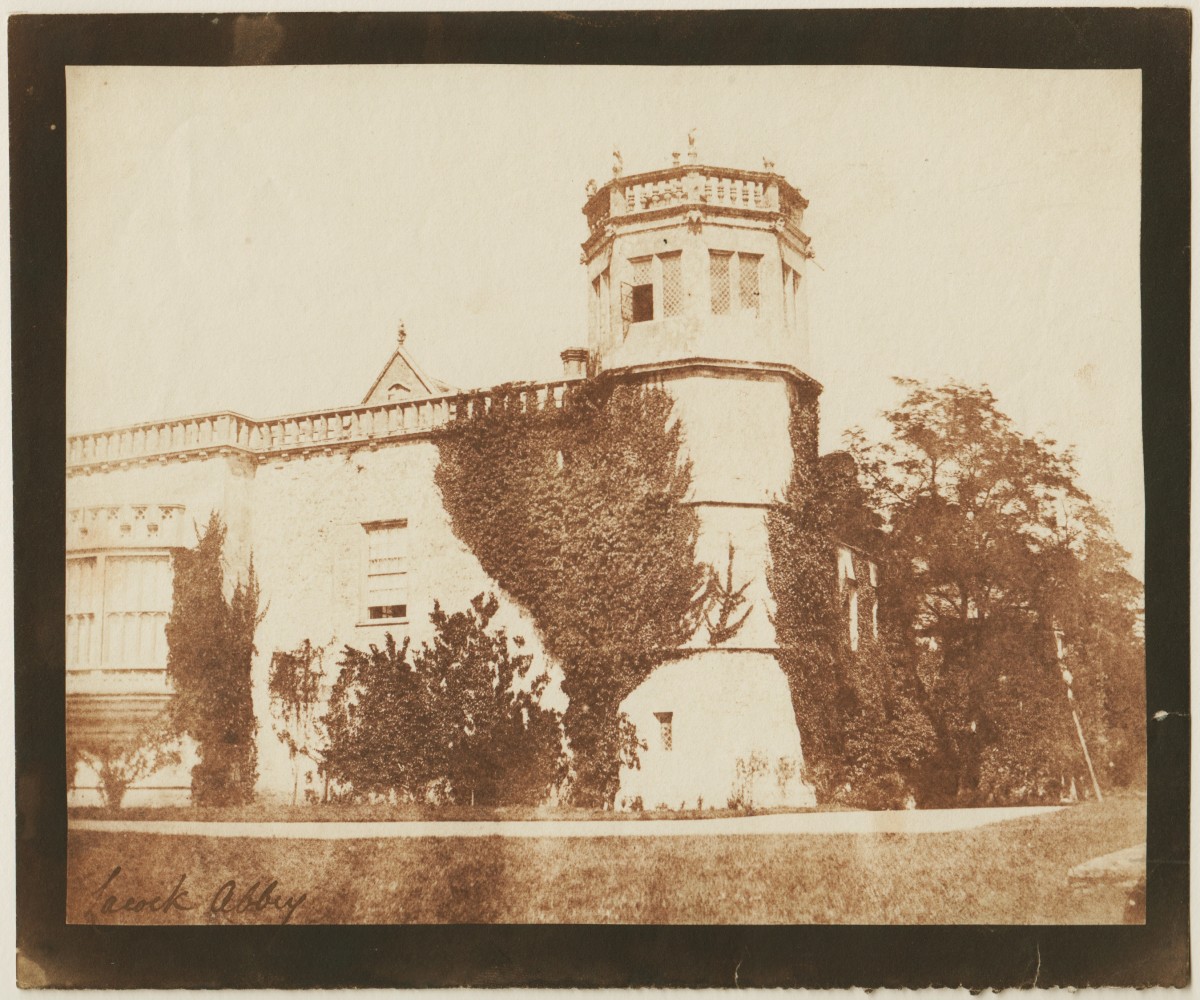
William Henry Fox Talbot (English, 1800-1877)
Sharington's Tower, "Lacock Abbey," 1845
Salt print from a calotype negative
16.4 x 20.5 cm on 18.7 x 22.4 cm paper
In the period following Talbot's discovery of the calotype negative process, he continued training his camera on the Abbey itself and its grounds. This image shows the 16th-century octagonal tower built by the Abbey's first lay owner and Talbot's ancestor, Sir William Sharington. Sharington's Tower housed the Magna Carta, now in the British Museum.
This print bears Talbot's ink title on the front rather than on the back and, as such, is uncommon. It indicates that Talbot designated it for presentation.
In this rare variant of Plate XIX in The Pencil of Nature there are two open windows.
Inquire
William Henry Fox Talbot (English, 1800-1877)
"The Ladder," 1844
Salt print from a calotype negative
17.1 x 18.3 cm on 19.6 x 23.8 cm paper
This unusually rich, untrimmed print of one of Talbot's best known images is the only one from The Pencil of Nature to include people, among whom is Talbot's Dutch assistant, Nicolaas Henneman. The length of exposure times in photography's early days prohibited the capture of people in motion. However, as Talbot explained, "when a group of persons has been artistically arranged, and trained by a little practice to maintain an absolute immobility for a few seconds of time, very delightful pictures are easily obtained." This picture presents an artificial tableau, carefully composed by Talbot to simulate actual activity.The creation of this picture was further complicated by the height of the loft door which might have forced Talbot to point the camera upwards, creating converging vertical lines unattractive to the artistic or pictorial eye. Instead, the picture presents a rather flat frontal composition, likely produced by elevating the position of his camera. In this finely executed composition we can see Talbot becoming one of the first photographic artists.
This image appeared as Plate XIV in Talbot's The Pencil of Nature. Arnold Crane told HPK in 2007 that when he agreed to sell his collection to the Getty Museum in 1984, he chose to keep this extraordinary print.
Inquire
William Henry Fox Talbot (English, 1800-1877)
South front of Lacock Abbey, towards Sharington's Tower, 1842-1843
Waxed salt print from a calotype negative
15.5 x 21.1 cm on 18.3 x 22.6 cm paper
This photograph is largely autobiographical, not only for being a representation of Talbot’s Wiltshire home, but also for emphasizing the personal stamp he put on the ancient Abbey. In the late 1820s, not long after he moved into the Abbey as a residence, Talbot embarked on an extensive remodeling of the South front, intending to create a gallery in which to hang works of art. The Oriel Window was one result of this, but his remodeling did not affect Sharingtons Tower, the home of the Lacock Magna Carta (now in the British Library). He distributed prints of this image to numerous colleagues, including Baron von Humboldt, and his mother, the Lady Elisabeth Feilding, titled it and included it in her 1844 album. The negative and all three other prints known to exist are in public collections.
Inquire
Charles Leander Weed (American, 1824-1903)
"Yo-semite Valley from the Mariposa Trail, Mariposa County, Cal.," 1864
Mammoth plate albumen print
43.3 x 52.5 cm
In 1854 New York-born Weed moved west to Sacramento. By 1858 he had formed a partnership with Robert Vance who obtained glass-plate equipment that Weed used to make his first photographs of the Yosemite region in 1859. The present photograph is a particularly fine example of the Yosemite photographs that Weed made in 1864 for the publishing firm Lawrence and Houseworth using a 17x21 inch mammoth-plate camera.
Inquire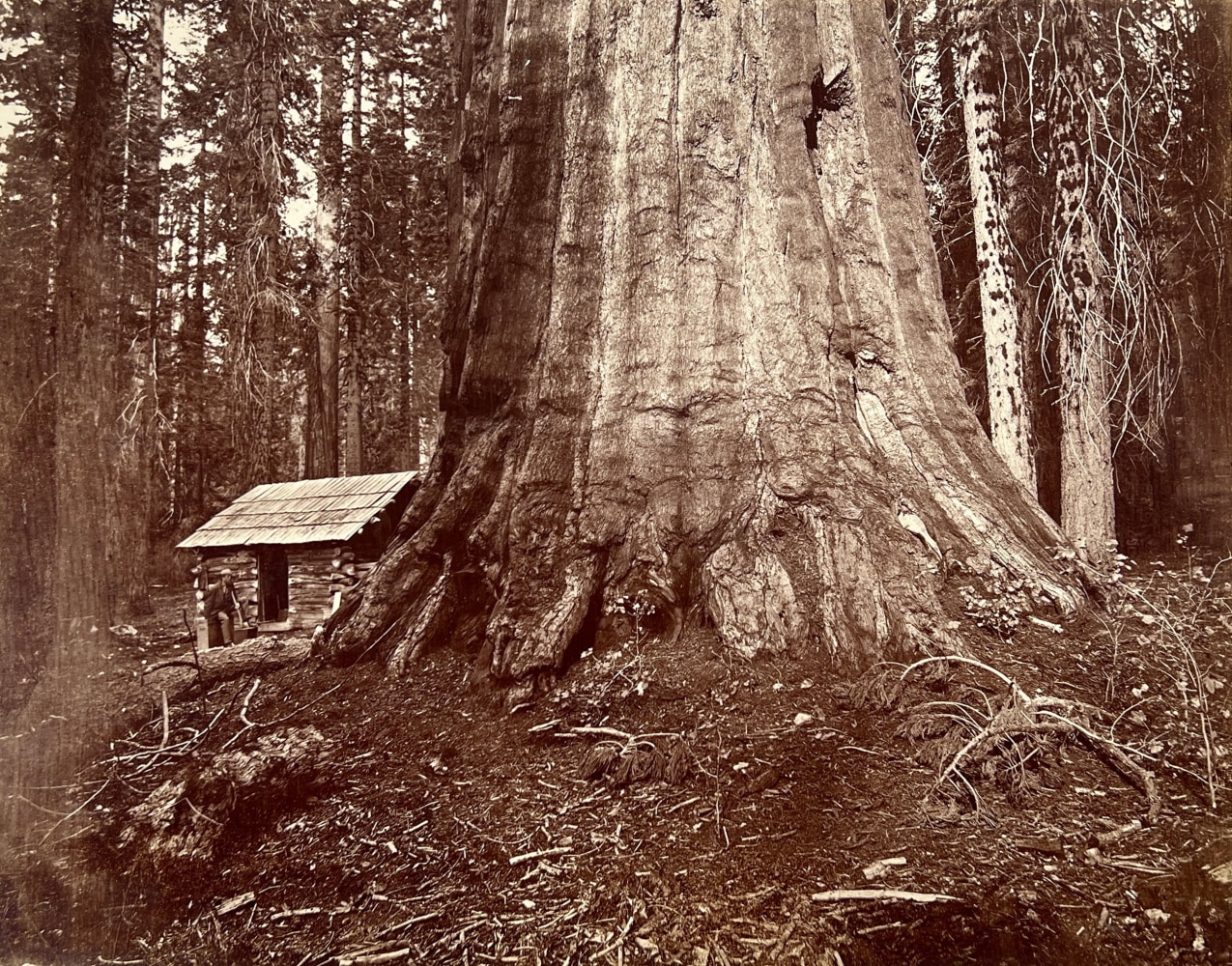
Eadweard J. Muybridge (American, born in England, 1830-1904)
"Wm H. Seward, Mariposa Mammoth Trees," Yosemite Valley, 1872
Mammoth plate albumen print
43.0 x 54.7 cm
Muybridge first came to the United States in 1850 representing English book publishers and by 1856 had opened an antiquarian book shop in San Francisco. A trip back to England in 1860 became a long stay, and when he returned to San Francisco in 1867 he was an accomplished photographer. His early work suggests the influence of British landscape photographers. Yosemite pictures were commercially popular, and it was natural that Muybridge photographed there. His 1872 views are his most significant landscape photographs and the public response to them was overwhelming.
Inquire
Eadweard J. Muybridge (American, born in England, 1830-1904)
Tenaya Canyon, from Union Point, Valley of the Yosemite, 1872
Mammoth plate albumen print
43.0 x 55.0 cm
Originally named Edward Muggeridge, and after changing names and professions several times, the colorful Eadweard Muybridge emerged as an accomplished landscape photographer in 1867. The present print is one of 45 mammoth-plate negatives he made during an 1872 visit to Yosemite. Considerable emphasis is placed on the immediate foreground resulting in a bold near-far spatial play.
Inquire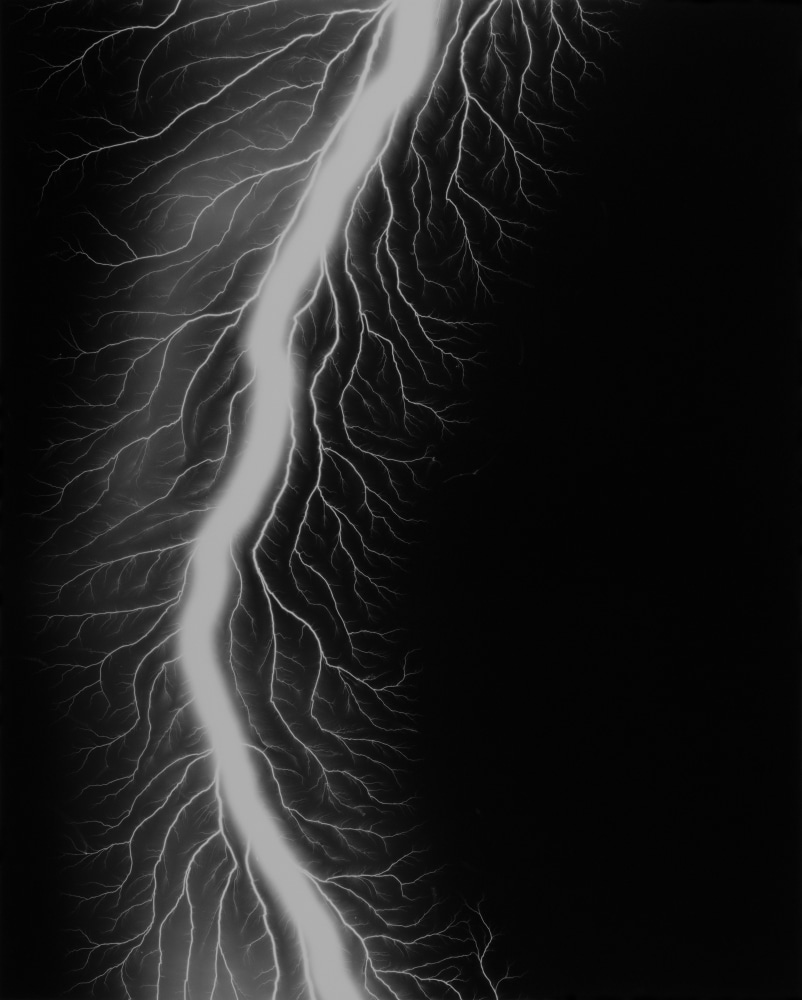
Hiroshi Sugimoto (Japanese, b. 1948)
"Lightning Fields 167," 2009
Gelatin silver print from a cameraless negative
58.4 x 47.0 cm framed to 85.0 x 72.0 cm
Edition 8/25
Made from dynamic camera-less negatives depicting electrical charges, and influenced in part by Talbot’s research into static electricity, Sugimoto’s lightning fields prints were made using a Van de Graaff generator to charge a metal ball with static. The negative pole was provided by a large metal tabletop on which was placed a sheet of film. The “lightning field” is formed by the spark resulting from Sugimoto moving the metal ball close to the metal tabletop once the electric charge reaches its desired strength. If the charge is powerful enough it creates the capillary effect of electric light so dramatically captured in Lightning Fields 167. The print is an enlargement from a selected portion of the negative.
Inquire
Hiroshi Sugimoto (Japanese, b. 1948)
"Lightning Fields 231," 2009
Gelatin silver print from a cameraless negative
58.4 x 47.0 cm framed to 85.0 x 72.0 cm
Edition 1/25
Dynamic camera-less photograms depicting electrical charges, influenced in part by Talbot’s research into static electricity, Sugimoto’s lightning fields were made using a Van de Graaff generator to charge a metal ball with static. The negative pole was provided by a large metal tabletop on which was placed a sheet of film. The “lightning field” is formed by the spark resulting from Sugimoto moving the metal ball close to the metal tabletop once the electric charge reaches its desired strength. If the charge is powerful enough it creates the capillary effect of electric light so dramatically captured in Lightning Fields 231. The print is an enlargement from a selected portion of the negative.
Inquire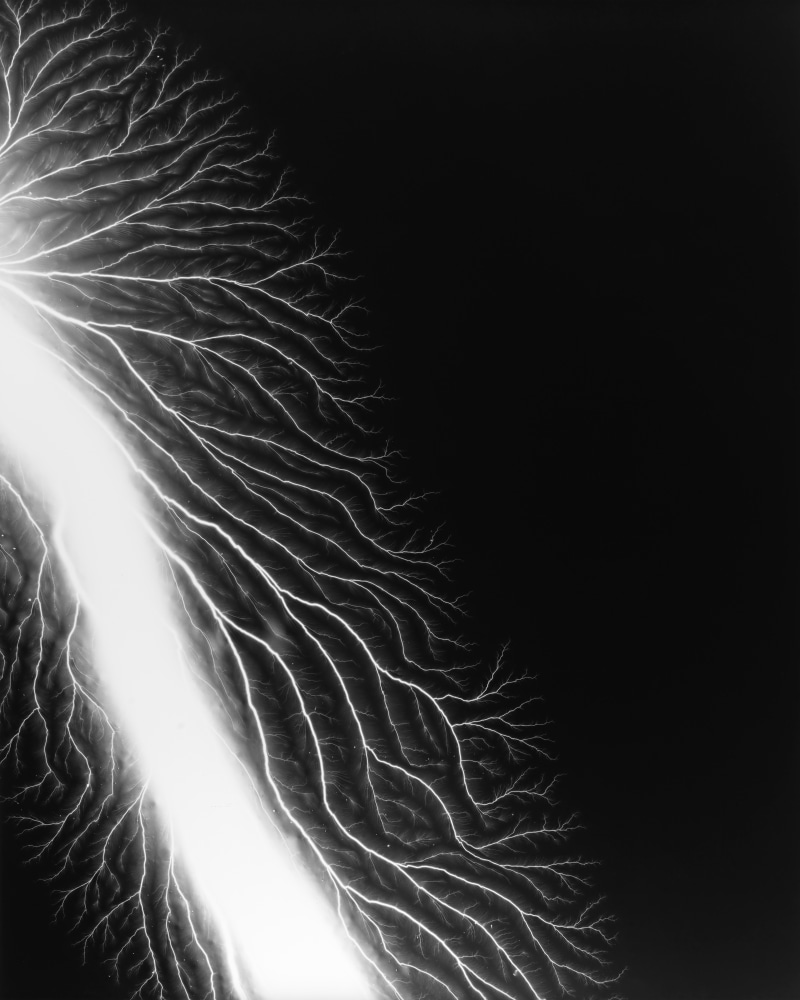
Hiroshi Sugimoto (Japanese, b. 1948)
"Lightning Fields 222," 2009
Gelatin silver print from a cameraless negative
58.4 x 47.0 cm framed to 85.0 x 72.0 cm
Edition 6/25
Made from dynamic camera-less negatives depicting electrical charges, influenced in part by Talbot’s research into static electricity, Sugimoto’s lightning fields were made using a Van de Graaff generator to charge a metal ball with static. The negative pole was provided by a large metal tabletop on which was placed a sheet of film. The “lightning field” is formed by the spark resulting from Sugimoto moving the metal ball close to the metal tabletop once the electric charge reaches its desired strength. If the charge is powerful enough it creates the capillary effect of electric light so dramatically captured in Lightning Fields 222. The print is an enlargement from a selected portion of the negative.
Inquire
Julia Margaret Cameron (English, born in India, 1815-1879)
"The Kiss of Peace," 1869
Albumen print from a collodion negative
35.1 x 28.1 cm
Cameron is known for her portraits of some of Victorian England's most celebrated figures and for her staged allegorical images drawn from literature, poetry and the Bible. "The Kiss of Peace" takes its inspiration from Alfred Lord Tennyson's poem "St. Agnes' Eve" of 1837. The costume on Cameron's sitters, Florence Anson (?) and Mary Hillier, Cameron's maid from 1861-1875, though of the Victorian period, makes no explicit reference to a specific historical era. The photograph's title alludes to an early Christian custom of greeting fellow worshippers with a "holy kiss," also known as the "kiss of peace," conveyed a blessing of peace to its recipient.
Cameron declared "The Kiss of Peace" to be "the most beautiful of all my photographs."
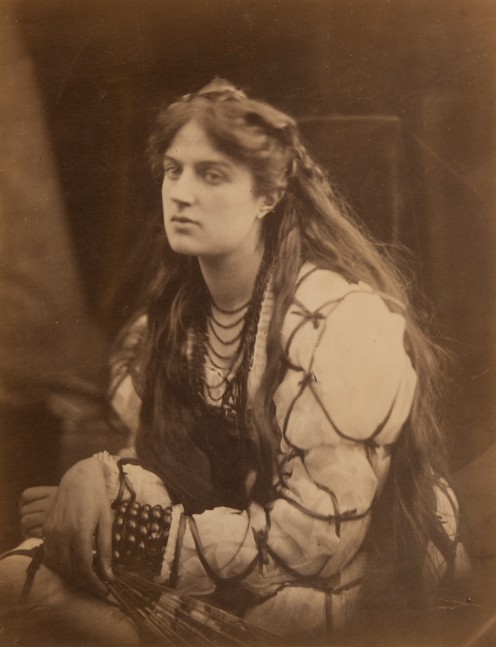
Julia Margaret Cameron (English, born in India, 1815-1879)
"Hypatia, Marie Spartali," 1867 or 1868
Albumen print from a wet collodion negative
31.9 x 24.8 cm
The model here presents a very different appearance from many of Cameron's other milkmaids and daughters of friends, perhaps because she herself was an artists' model and an accomplished watercolorist. Marie Euphrosyne Spartali (1843-1927) was the daughter of the Greek consul in London. A pupil of the Pre-Raphaelite painter Ford Madox Brown, she first exhibited at the Dudley Gallery and in 1867, about the time of this photograph, she was admitted into the Royal Academy. Spartali married the American painter and photographer William James Stillman (1828-1901) in 1871. Before posing for Cameron, she had modeled for Dante Gabriel Rossetti, Ford Madox Brown and for Edward Burne-Jones.
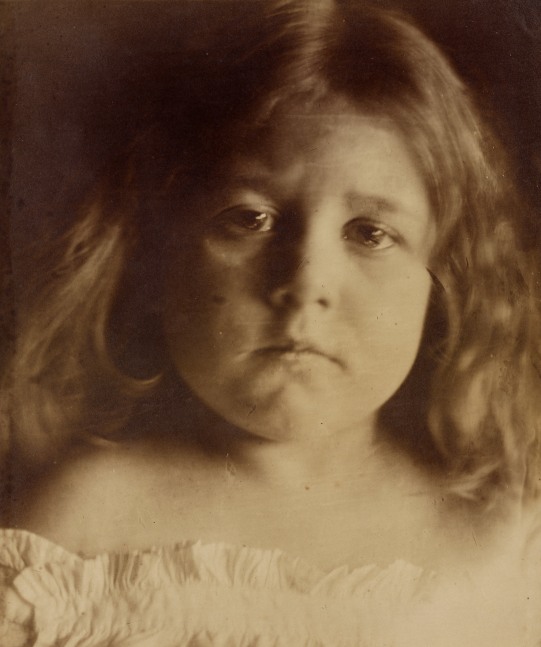
Julia Margaret Cameron (English, born in India, 1815-1879)
"Baby Blossom" Alice Keown, circa 1866
Albumen print from a wet collodion negative
34.1 x 27.8 cm
This almost larger-than-life head was well known to Cameron. It belonged to Alice Jessie Keown, who was born in Freshwater, near the Camerons, on 25 April 1861, the third daughter of Thomas Keown. In 1892, she married Henry Percival Johnson. Cameron also photographed Alice’s older sister Elizabeth and her younger brother Percy. Alice herself was never known as Baby Blossom, so perhaps Cameron took her inspiration from Ida White’s recently published poem. According to Cox & Ford, one other print of this image is known.

William Henry Fox Talbot (English, 1800-1877)
Sharington's Tower, "Lacock Abbey," 1845
Salt print from a calotype negative
16.4 x 20.5 cm on 18.7 x 22.4 cm paper
In the period following Talbot's discovery of the calotype negative process, he continued training his camera on the Abbey itself and its grounds. This image shows the 16th-century octagonal tower built by the Abbey's first lay owner and Talbot's ancestor, Sir William Sharington. Sharington's Tower housed the Magna Carta, now in the British Museum.
This print bears Talbot's ink title on the front rather than on the back and, as such, is uncommon. It indicates that Talbot designated it for presentation.
In this rare variant of Plate XIX in The Pencil of Nature there are two open windows.
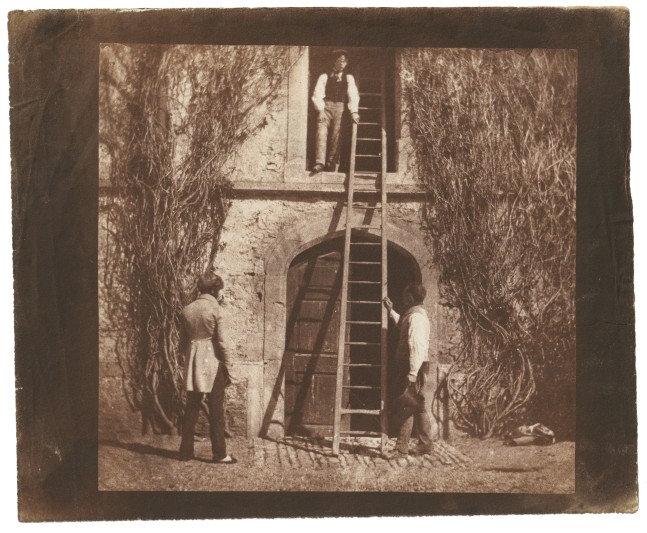
William Henry Fox Talbot (English, 1800-1877)
"The Ladder," 1844
Salt print from a calotype negative
17.1 x 18.3 cm on 19.6 x 23.8 cm paper
This unusually rich, untrimmed print of one of Talbot's best known images is the only one from The Pencil of Nature to include people, among whom is Talbot's Dutch assistant, Nicolaas Henneman. The length of exposure times in photography's early days prohibited the capture of people in motion. However, as Talbot explained, "when a group of persons has been artistically arranged, and trained by a little practice to maintain an absolute immobility for a few seconds of time, very delightful pictures are easily obtained." This picture presents an artificial tableau, carefully composed by Talbot to simulate actual activity.The creation of this picture was further complicated by the height of the loft door which might have forced Talbot to point the camera upwards, creating converging vertical lines unattractive to the artistic or pictorial eye. Instead, the picture presents a rather flat frontal composition, likely produced by elevating the position of his camera. In this finely executed composition we can see Talbot becoming one of the first photographic artists.
This image appeared as Plate XIV in Talbot's The Pencil of Nature. Arnold Crane told HPK in 2007 that when he agreed to sell his collection to the Getty Museum in 1984, he chose to keep this extraordinary print.
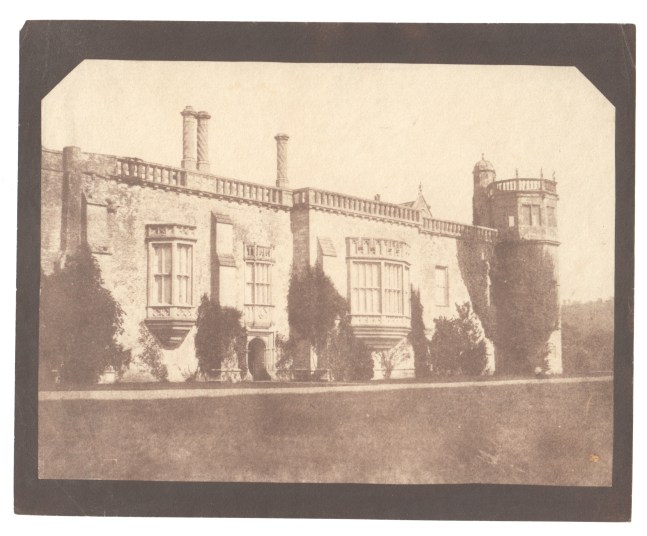
William Henry Fox Talbot (English, 1800-1877)
South front of Lacock Abbey, towards Sharington's Tower, 1842-1843
Waxed salt print from a calotype negative
15.5 x 21.1 cm on 18.3 x 22.6 cm paper
This photograph is largely autobiographical, not only for being a representation of Talbot’s Wiltshire home, but also for emphasizing the personal stamp he put on the ancient Abbey. In the late 1820s, not long after he moved into the Abbey as a residence, Talbot embarked on an extensive remodeling of the South front, intending to create a gallery in which to hang works of art. The Oriel Window was one result of this, but his remodeling did not affect Sharingtons Tower, the home of the Lacock Magna Carta (now in the British Library). He distributed prints of this image to numerous colleagues, including Baron von Humboldt, and his mother, the Lady Elisabeth Feilding, titled it and included it in her 1844 album. The negative and all three other prints known to exist are in public collections.

Charles Leander Weed (American, 1824-1903)
"Yo-semite Valley from the Mariposa Trail, Mariposa County, Cal.," 1864
Mammoth plate albumen print
43.3 x 52.5 cm
In 1854 New York-born Weed moved west to Sacramento. By 1858 he had formed a partnership with Robert Vance who obtained glass-plate equipment that Weed used to make his first photographs of the Yosemite region in 1859. The present photograph is a particularly fine example of the Yosemite photographs that Weed made in 1864 for the publishing firm Lawrence and Houseworth using a 17x21 inch mammoth-plate camera.

Eadweard J. Muybridge (American, born in England, 1830-1904)
"Wm H. Seward, Mariposa Mammoth Trees," Yosemite Valley, 1872
Mammoth plate albumen print
43.0 x 54.7 cm
Muybridge first came to the United States in 1850 representing English book publishers and by 1856 had opened an antiquarian book shop in San Francisco. A trip back to England in 1860 became a long stay, and when he returned to San Francisco in 1867 he was an accomplished photographer. His early work suggests the influence of British landscape photographers. Yosemite pictures were commercially popular, and it was natural that Muybridge photographed there. His 1872 views are his most significant landscape photographs and the public response to them was overwhelming.

Eadweard J. Muybridge (American, born in England, 1830-1904)
Tenaya Canyon, from Union Point, Valley of the Yosemite, 1872
Mammoth plate albumen print
43.0 x 55.0 cm
Originally named Edward Muggeridge, and after changing names and professions several times, the colorful Eadweard Muybridge emerged as an accomplished landscape photographer in 1867. The present print is one of 45 mammoth-plate negatives he made during an 1872 visit to Yosemite. Considerable emphasis is placed on the immediate foreground resulting in a bold near-far spatial play.

Hiroshi Sugimoto (Japanese, b. 1948)
"Lightning Fields 167," 2009
Gelatin silver print from a cameraless negative
58.4 x 47.0 cm framed to 85.0 x 72.0 cm
Edition 8/25
Made from dynamic camera-less negatives depicting electrical charges, and influenced in part by Talbot’s research into static electricity, Sugimoto’s lightning fields prints were made using a Van de Graaff generator to charge a metal ball with static. The negative pole was provided by a large metal tabletop on which was placed a sheet of film. The “lightning field” is formed by the spark resulting from Sugimoto moving the metal ball close to the metal tabletop once the electric charge reaches its desired strength. If the charge is powerful enough it creates the capillary effect of electric light so dramatically captured in Lightning Fields 167. The print is an enlargement from a selected portion of the negative.
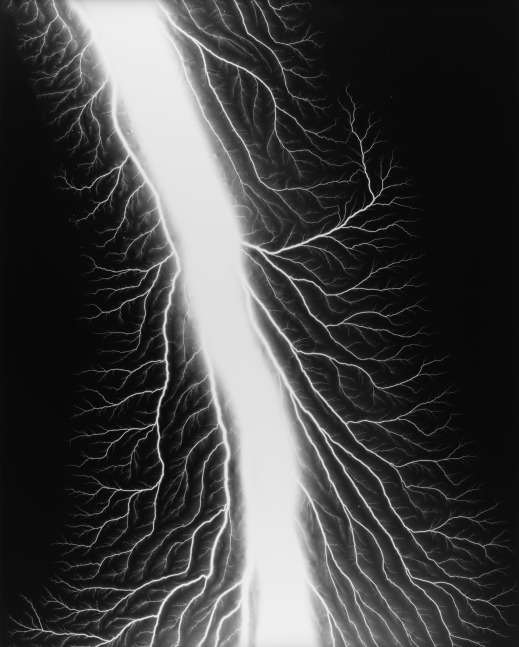
Hiroshi Sugimoto (Japanese, b. 1948)
"Lightning Fields 231," 2009
Gelatin silver print from a cameraless negative
58.4 x 47.0 cm framed to 85.0 x 72.0 cm
Edition 1/25
Dynamic camera-less photograms depicting electrical charges, influenced in part by Talbot’s research into static electricity, Sugimoto’s lightning fields were made using a Van de Graaff generator to charge a metal ball with static. The negative pole was provided by a large metal tabletop on which was placed a sheet of film. The “lightning field” is formed by the spark resulting from Sugimoto moving the metal ball close to the metal tabletop once the electric charge reaches its desired strength. If the charge is powerful enough it creates the capillary effect of electric light so dramatically captured in Lightning Fields 231. The print is an enlargement from a selected portion of the negative.

Hiroshi Sugimoto (Japanese, b. 1948)
"Lightning Fields 222," 2009
Gelatin silver print from a cameraless negative
58.4 x 47.0 cm framed to 85.0 x 72.0 cm
Edition 6/25
Made from dynamic camera-less negatives depicting electrical charges, influenced in part by Talbot’s research into static electricity, Sugimoto’s lightning fields were made using a Van de Graaff generator to charge a metal ball with static. The negative pole was provided by a large metal tabletop on which was placed a sheet of film. The “lightning field” is formed by the spark resulting from Sugimoto moving the metal ball close to the metal tabletop once the electric charge reaches its desired strength. If the charge is powerful enough it creates the capillary effect of electric light so dramatically captured in Lightning Fields 222. The print is an enlargement from a selected portion of the negative.
